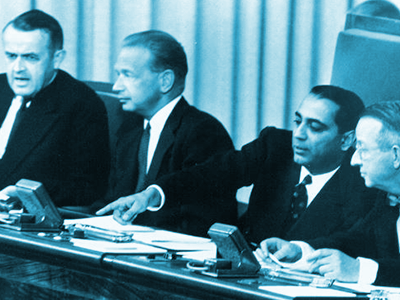Nuclear physicist, Father of nuclear program

Childhood:
Hemi J.Bhabha was born in Bombay now called Mumbai in October 30, 1909. He was born in a wealthy parsi family. His father Jehangir Hormusji Bhabha was studied in Oxford and worked as a lawyer. His mother Meheren was the granddaughter of Sir Dinshaw Maneckji Petit. He is widely respected in Bombay for philanthropic endowments. His grandfather is an education inspector in the state of Mysore. Hormusji’s sister that is his aunt, his mother’s sister married Sir Dorab J. Tata. He was the eldest son of Jamshetji Nusserwanji Tata.
Education:
Homi J.Bhabha received his schooling from Bombay’s Cathedral and John Connon School. After that at age 15, he entered the Elphinstone College. Bhabha passed the senior level Cambridge examination with honours. On 1927, he attended Royal Institute of Science after that he studied in Caius College of Cambridge University. This is because his father and his uncle from Tata want him to learn engineering. They wanted him to get a Mechanical Engineering degree and return in Tata Steel Mills in Jamshedpur as a metallurgist.
Homi J. Bhabha and physics:
Although he joined in engineering college, Homi J.Bhabha was very much interested to physics. In a letter he wrote to his father as seriously engineering or business is not the thing for me on 1932. He told that the engineering is totally opposite to my opinions and temperament. Bhabha told that Physics is my line and I will do great things here. So he convinced his father and earned Ph.D. in nuclear physics on 1934. He got a lot of interest in physics. So he completed another degree in Physics. He got his doctorate in nuclear physics after completing his first scientific paper “The Absorption of Cosmic Radiation”. Later based on his paper the process of electron-positron scattering is named after his name as “Bhabha scattering”.
Early Life:
Homi J.Bhabha initially started his nuclear journey in Britain. But for his annual vacation he visited India. But due to World War 2 he was forced to stay in India. So he become the reader of Physics at Indian Institute of Science in Bengaluru, which is headed by Nobel laureate C.V. Raman.
Bhabha convicted a lot of Congress party leader to start a nuclear program in India. He is the upcoming prime minister of the year. Now as a part of it Homi J. Bhabha established Cosmic Ray Research Unit at the Institute.
Homi J. Bhabha important works:
Bhabha while studying for the Mathematical Tripos worked at Cavendish Laboratory. At the same time he worked for his physics doctorate. The laboratory he used to work did a lot of breakthrough in scientific researches like neutron was discovered by Chadwick; Transmutations of lithium with protons was discovered by John Cockcroft and Ernest Walton and gamma radiation showers, electron pair productions are demonstrated by Patrick Blackett and Giuseppe Occhialini in the cloud chambers of the lab.
The lifetime passion of Bhabha was to conduct experiments on particles and the particles emitting enormous amount of radiation. Because of his leading edge experiments on Physics and nuclear energy many Indian laureates switched their interest to nuclear physics. One of them was Piara Singh Gill. Homi J. Bhabha gave an explanation on the “The Absorption of Cosmic radiation”. He also explained production of electron shower in cosmic rays. This helped Isaac Newton to win his studentship in 1934.
Homi J. Bhabha and nuclear physics:

Bhabha finished his doctoral in theoretical physics under Ralph H. Fowler. On his studentship he split his time to work on Niels Bohr in Copenhagen and at Cambridge. On 1935 he published a paper called Proceedings of the Royal Society, Series A. In which he explained the calculation to find the cross section of electron-positron scattering. This process was later named as Bhabha scattering process.
After Proceedings of the Royal Society, Series A, he co-authored “The Passage of Fast Electrons and the Theory of Cosmic Showers” along with Walter Heitler on 1963. In this paper he explained the process of cosmic rays from outer space interacting with the upper atmosphere to produce number of electrons in a cascading process. They differ from different altitudes for different electron initiation energies.
A few years after Bruno Rossi and Pierre Victor Auger made an experimental observation on cosmic rays of Bhabha calculations. The experiment completely got matched with their calculations.
Homi J. Bhabha awards and achievements:
- Homi J. Bhabha has received Salomons Studentship in Engineering on 1931.
- And on 1932 he got the Rouse ball travelling Studentship in Maths after getting first class in maths Tripos.
- On 1942, Homi J. Bhabha got his Adams price. And on 1954, for his great contribution on nuclear physics Padma Bhushan award was conferred to him.
- On 1954, he founded nuclear research center at Trombay. This was later named as Bhabha Atomic Research Centre (BARC).
- Homi J. Bhabha is the first chairman of the Atomic Energy Commission of India on 1948.
- He was awarded the Senior Studentship of the 1851 exhibition on 1937.
- The council called the Homi Bhabha Fellowship has been giving Homi Bhabha Fellowships from the year 1967.
Homi J. Bhabha death:
Homi J. Bhabha was killed in an air crash. This happens on Mont Blanc peak of the Alps on January 24, 1966. During the crash he was on his way to Vienna. That is to attend a Scientific Advisory Committee meeting on International Atomic Energy. While he is dead, he was the Atomic Energy department secretary in the Government of India. Also Homi J. Bhabha is the ex – officio chairman of the Indian Atomic energy commission and the director of Tata Institute of fundamental research.
